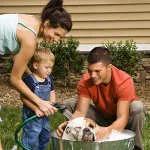Parents’ words and anxiety disorders – part 4

A series of studies has investigated the transfer of information as a pathway to fear. One study asked children to perform a behavioral task involving novel animals, but first, children were read either positive, neutral or negative stories regarding the animals. Those children presented with negative stories showed a significant increase whereas those presented with positive stories showed a significant decrease. Those presented with no information showed no change during the behavioral task (Field & Lawson, 2003). One study used the same design; however, the experimenters presented information about social fear beliefs not novel animals. The study showed that children provided with negative information about uncommon social interactions showed increased social fear beliefs (Field, Lawson & Manerjee, 2008). Therefore, it appears that specific positive and negative information can change the way that children behave not only with novel non-social objects, such as animals, but it can also change the way they behave socially.
While these findings are interesting, further examination of literature using similar methods shed more light on the importance of other aspects of information transfer. Research has also shown that even after six months time, when presented with negative information, children still show behavioral avoidance. This finding was the strongest for those children between six and eight years old (Field, Lawson & Manerjee, 2008). But what about the source of information? Well it appears that the effect of negative information has the largest effect when it is presented to a child by an adult, rather than a peer or a non-informative control source (Field, Argyris & Knowles, 2001).
Thus it appears that specific positive or negative information does influence the behavior of children. In the next installment in the series I will be further discussing the effect of maternal psychopathology and child anxiety on mother-child conversations.
BIBLIOGRAPHY:
- Field, A. P., & Lawson, J. (2003). Fear information and the development of fears during childhood: Effects on implicit fear responses and behavioral avoidance. Behavior Research and Therapy, 41, 1277 – 1293.
- Field, A. P., Lawson, J., & Banerjee, R. (2008). The verbal threat information pathway to fear in children: The longitudinal effects on fear cognitions and the immediate effects on avoidance behavior. Journal of Abnormal Psychology, 117, 1, 214 – 224.
- Field, A. P., Argyris, N. G., & Knowles, K. A. (2001). Who‟s afraid of the big bad wolf: A prospective paradigm to test Rachman‟s indirect pathways in children. Behavior Research and Therapy, 39, 1259 – 1276.
| READ ALSO: | – Part 1 – | Part 2 – | Part 3
|


